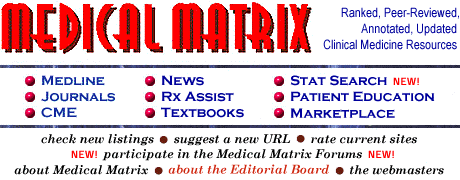




"This is your brain in pictures. The best visual representation of what's inside your head gets even better. How many other sites offer you the top 100 (actually 106) brain structures? Each sub-page here consists of a nifty graphic and plenty of medical terms that, quite frankly, we don't understand. The folks at Harvard also display the visual results of brain ailments like stroke and Alzheimer's -- even Mad Cow Disease. Some section contain accompanying lecture notes and nearly all are geared for the medical student. Still, it's one of the first (and best) examples of what the Web can do to help explain the human body. A classic."

Review: This extremely sophisticated site bills itself as an information resource for central nervous system imaging. It's not for the squeamish, though, as it combines clinical data with magnetic resonance (MR), X-ray computed tomography (CT), and nuclear medicine images to show what goes on between your ears. Not always a pretty site, that.

Stanford MedWorld 



Whole Brain Atlas: "An incredible collection of MR images of the brain. A well designed and easy to use web site that includes 'Tours' of pathological conditions as well as MPEG movies. Also offers a self-quiz on anatomical structures. The on-line atlas has sections on normal brain, cerebrovascular disease, neoplastic disease, degenerative disease, and inflammatory/infectious disease."
 Neurosciences on the Internet, "Best Bet".
Neurosciences on the Internet, "Best Bet".Whole Brain Atlas : "The title says it all! Both still and moving images form an atlas of the human brain in health and disease."

"Take a road trip of the brain at Harvard Medical School's Whole Brain Atlas. This ambitious research and educational site is a catalog of medical images of actual human brains--from models that are normal and healthy to specimens with diseased, injured, and disordered tissue. Set off by examining some of the more than 100 different structures in the brain, and catch up on normal brain function and anatomy. For the lay user, the neuroimaging primer explains some of the different tools used to collect these images. After you amass a little background knowledge, dive into the various sections of the noble lobe. Especially stimulating are the tours that use images and text to explain the progression of Alzheimer's disease, brain tumors, and herpes encephalitis. Normal aging also produces many changes in gray matter, visible in the brain of a healthy 76-year-old woman who participated in the research project. Many of the images on this site are accompanied by time-lapse video showing alterations to the brain, while a Java-based navigator lets you study the different disorders more easily. For anyone interested in what really goes on inside people's heads, the Whole Brain Atlas is the place to visit. (7/9/97)


 Atlas of normal and pathologic structure images, and multiplanar and vascular anatomy which integrates clinical information with MR, CT, and nuclear medicine images. The atlas covers acute stroke, subdural hematoma, and cavernous angioma, etc. arteriovenous malformation, hypertensive encephalopathy, glioma, meningioma, alzheimer's disease, huntington's disease, motor neuron disease, pick's disease, multiple sclerosis, lyme encephalopathy, herpes encephalitis and Creutzfeld-Jakob disease. Harvard.
Atlas of normal and pathologic structure images, and multiplanar and vascular anatomy which integrates clinical information with MR, CT, and nuclear medicine images. The atlas covers acute stroke, subdural hematoma, and cavernous angioma, etc. arteriovenous malformation, hypertensive encephalopathy, glioma, meningioma, alzheimer's disease, huntington's disease, motor neuron disease, pick's disease, multiple sclerosis, lyme encephalopathy, herpes encephalitis and Creutzfeld-Jakob disease. Harvard.
